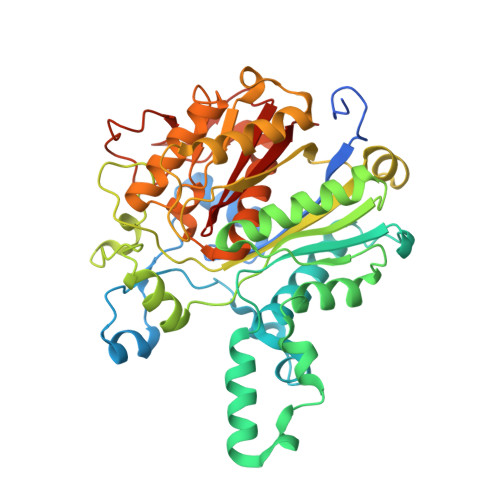Structural Basis for the Recognition of Mycolic Acid Precursors by Kasa, a Condensing Enzyme and Drug Target from Mycobacterium Tuberculosis
Schiebel, J., Kapilashrami, K., Fekete, A., Bommineni, G.R., Schaefer, C.M., Mueller, M.J., Tonge, P.J., Kisker, C.(2013) J Biol Chem 288: 34190
- PubMed: 24108128
- DOI: https://doi.org/10.1074/jbc.M113.511436
- Primary Citation of Related Structures:
4C6U, 4C6V, 4C6W, 4C6X, 4C6Z, 4C70, 4C71, 4C72, 4C73 - PubMed Abstract:
The survival of Mycobacterium tuberculosis depends on mycolic acids, very long α-alkyl-β-hydroxy fatty acids comprising 60-90 carbon atoms. However, despite considerable efforts, little is known about how enzymes involved in mycolic acid biosynthesis recognize and bind their hydrophobic fatty acyl substrates. The condensing enzyme KasA is pivotal for the synthesis of very long (C38-42) fatty acids, the precursors of mycolic acids. To probe the mechanism of substrate and inhibitor recognition by KasA, we determined the structure of this protein in complex with a mycobacterial phospholipid and with several thiolactomycin derivatives that were designed as substrate analogs. Our structures provide consecutive snapshots along the reaction coordinate for the enzyme-catalyzed reaction and support an induced fit mechanism in which a wide cavity is established through the concerted opening of three gatekeeping residues and several α-helices. The stepwise characterization of the binding process provides mechanistic insights into the induced fit recognition in this system and serves as an excellent foundation for the development of high affinity KasA inhibitors.
Organizational Affiliation:
Rudolf Virchow Center for Experimental Biomedicine, Institute for Structural Biology, University of Wuerzburg, D-97080 Wuerzburg, Germany; Institute of Pharmacy and Food Chemistry, University of Wuerzburg, Am Hubland, D-97074 Wuerzburg, Germany.


















